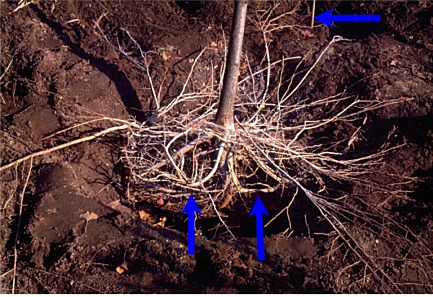Home > Root growth > Root depth in the landscape > Root growth in compacted soil
Root growth in compacted soil

This honeylocust was planted in compacted (1.8 g/cc) sandy loam landscape soil as a bare-root 1 inch caliper tree in USDA hardiness zone 6 four years before it was excavated. As roots attempted to grow into the landscape soil, they were deflected (see bottom 2 arrows) by the mechanical impedance and low oxygen present in the compacted soil.
Most roots appeared to spiral around inside the original planting hole. Several were able to escape by growing up the side of the planting hole. They proliferated once they reached the well aerated soil at the soil surface. Large gaps in the root system can result from planting in compacted soil as shown above.
Note that there are no roots growing on the near side of the tree-most grew into landscape soil on the far side of the tree resulting in a one-sided root system. The fate of the root growing toward the tree indicated by the top arrow can be seen in the next photo.

